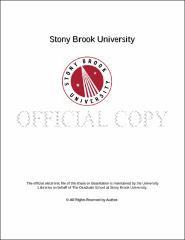| dc.identifier.uri | http://hdl.handle.net/11401/76745 | |
| dc.description.sponsorship | This work is sponsored by the Stony Brook University Graduate School in compliance with the requirements for completion of degree. | en_US |
| dc.format | Monograph | |
| dc.format.medium | Electronic Resource | en_US |
| dc.language.iso | en_US | |
| dc.publisher | The Graduate School, Stony Brook University: Stony Brook, NY. | |
| dc.type | Dissertation | |
| dcterms.abstract | From the Tevatron and the LHC data, it is clear that current models for the heavy quarkonium production are not able to explain the polarization of produced heavy quarkonia at large transverse momentum p<sub>T</sub>. A new approach to evaluate the heavy quarkonium production, by expanding the cross section in powers of 1/p<sub>T</sub> before the expansion in powers of &alpha<sub>s</sub>, was proposed recently. In terms of the QCD factorization, it is proved that both the leading and next-to-leading power terms in 1/p<sub>T</sub> for the cross sections can be systematically factorized to all orders in powers of &alpha<sub>s</sub>. The predictive power of this new QCD factorization formalism depends on several unknown but universal fragmentation functions (FFs) at an input scale of the order of heavy quarkonium mass m<sub>Q</sub>. These FFs should be extracted from the data in principle. However, fitting so many unknown multi-variable functions from the data is formidable practically. The lack of knowledge of the input FFs impedes the application of the QCD factorization. In this dissertation, inspired by the fact that these input FFs depend on m<sub>Q</sub> >> Lambda<sub>QCD<\sub>, we apply the NRQCD factorization formalism to further separate the perturbative and non-perturbative interactions. With our calculations, all the input unpolarized FFs are expressed as complicated functions with a few unknown NRQCD long-distance matrix elements (LDMEs). In addition, by general symmetry arguments, we successfully generalize the polarized NRQCD four-fermion operators to <italic>d</italic> dimensions and calculate the polarized FFs with conventional dimensional regularization. In the first application of the QCD factorization to unpolarized J/psi production, we find those NRQCD channels, which are expected to be important in the J/psi polarization, are actually dominated by the next-to-leading-power term in the p<sub>T</sub> expansion at current collider energies. Therefore the QCD factorization is very promising to solve the long standing heavy quarkonium polarization puzzle. | |
| dcterms.available | 2017-09-20T16:51:06Z | |
| dcterms.contributor | Sterman, George | en_US |
| dcterms.contributor | Qiu, Jian-Wei | en_US |
| dcterms.contributor | Deshpande, Abhay | en_US |
| dcterms.contributor | Weinacht, Thomas | en_US |
| dcterms.contributor | Morrison, David. | en_US |
| dcterms.creator | Zhang, Hong | |
| dcterms.dateAccepted | 2017-09-20T16:51:06Z | |
| dcterms.dateSubmitted | 2017-09-20T16:51:06Z | |
| dcterms.description | Department of Physics. | en_US |
| dcterms.extent | 181 pg. | en_US |
| dcterms.format | Application/PDF | en_US |
| dcterms.format | Monograph | |
| dcterms.identifier | http://hdl.handle.net/11401/76745 | |
| dcterms.issued | 2014-12-01 | |
| dcterms.language | en_US | |
| dcterms.provenance | Made available in DSpace on 2017-09-20T16:51:06Z (GMT). No. of bitstreams: 1
Zhang_grad.sunysb_0771E_12047.pdf: 1878792 bytes, checksum: 701dcb01694b149eb1f21a52ca38bea7 (MD5)
Previous issue date: 1 | en |
| dcterms.publisher | The Graduate School, Stony Brook University: Stony Brook, NY. | |
| dcterms.subject | factorization, fragmentation, Heavy quarkonium, QCD | |
| dcterms.subject | Nuclear physics | |
| dcterms.title | QCD factorization for heavy quarkonium production and fragmentation functions | |
| dcterms.type | Dissertation | |

